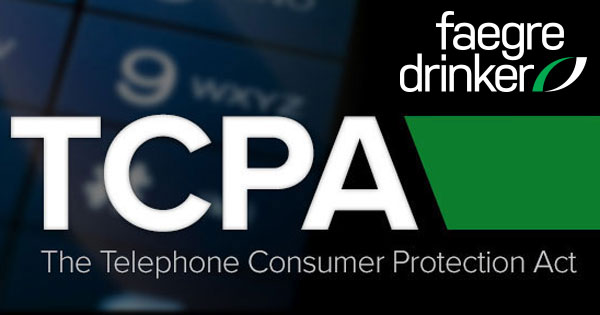On September 21, the FCC’s Consumer and Governmental Affairs Bureau issued a declaratory ruling clarifying that businesses advertised via fax should not face “sender liability” for unsolicited faxes sent without prior authorization. See Declaratory Ruling at ¶¶ 9, 17, In the Matter of Akin Gump, CG Docket No. 02-278 (Sept. 21, 2020). This ruling provides some much-needed guidance on the scope of sender liability under the Junk Fax Prevention Act, an issue which has divided the courts.
In 2005, the Junk Fax Prevention Act amended the TCPA to prohibit the sending of unsolicited advertisements via facsimile, absent some excepted relationship between sender and recipient. See Pub. L. No. 109-21, 119 Stat. 359 (2005). The FCC has defined the “sender” of a fax for liability purposes as any “person or entity on whose behalf a facsimile unsolicited advertisement is sent or whose goods or services are advertised or promoted in the unsolicited advertisement.” 47 C.F.R. § 64.1200(f)(10) (2019).[1] The Commission also has observed that the “sender” of a fax is usually, but not always, the business advertised in the fax. See “2006 Junk Fax Order,” FCC Rcd. 3787, 3808, ¶ 39 (2006).
From this guidance, courts have developed varying tests for junk-fax sender liability, creating inconsistent standards of conduct for businesses across jurisdictions. See, e.g., Bridgeview Health Care Center v. Clark, 816 F.3d 935, 937 (7th Cir. 2016) (applying principles of agency law); Imhoff Investment, LLC v. Alfoccino, Inc., 792 F.3d 627, 634 (6th Cir. 2015) (adopting strict liability); Palm Beach Golf Center-Boca v. John G. Sarris, DDS, 771 F.3d 1274, 1257-58 (11th Cir. 2014) (adopting distinct multi-factor test); FDS Restaurant, Inc. v. All Plumbing, Inc., 2020 WL 1465919, at *15 (D.C. Mar. 26, 2020) (adopting agency approach); Bais Yaakov of Spring Valley v. Educational Testing Service, 367 F. Supp. 3d 93, 117 (S.D.N.Y. 2019) (adopting multi-factor test from Palm Beach, supra); E&G, Inc. v. Mount Vernon Mills, Inc., 316 F. Supp. 3d 908, 912 (D.S.C. 2018) (recognizing multi-factor test); Physician’s Healthscore, Inc. v. Vertex Pharms., Inc., 247 F. Supp. 3d 138, 152 (D. Mass. 2017) (holding that the “only relevant consideration” in determining sender liability is whether “the defendant hired an independent contractor to transmit facsimile[] advertise[ments]”); Supply Pro Sorbents, LLC v. RingCentral, Inc., 2016 WL 5870111, at *3 (N.D. Cal. Oct. 7, 2016) (following Sixth Circuit’s strict liability approach); Bais Yaakov v. Varitronics, LLC, 2015 WL 1529279, at *4 (D. Minn. Apr. 3, 2015) (rejecting strict liability). (We previously blogged about the circuit split over sender liability, here.) Last year, Akin Gump filed a Petition for Expedited Clarification, asking the FCC to clarify the correct test for sender liability.
The FCC’s declaratory ruling holds that a business advertised via fax does not face liability for the unlawful dissemination of facsimile advertisements by a third party, so long as the advertised business did not direct or otherwise authorize the unlawful conduct. The order states, “[A] fax broadcaster may be exclusively liable for TCPA violations where it engages in deception or fraud against the advertise[d] [business]” in the course of an advertising campaign, such as by falsely representing that it has consent to fax certain individuals, see Declaratory Ruling, supra, at ¶ 9 (emphasis added), or by misrepresenting the number of recipients of an upcoming facsimile blast, see id. at ¶ 14 (citing Bridgeview, 816 F.3d at 939). When an advertising contractor makes misrepresentations pertaining to the legality of its services, the contractor itself is the sole sender of the faxes “because it is acting contrary to the advertise[d] [business’s] interests, and thus not ‘on behalf of’ the [advertised business].” Id. at ¶ 9 (quoting FCC “sender” definition).
In other words, “[w]here the fax broadcaster deliberately acts without the advertise[d] [business’s] authorization and contrary to the advertiser’s directives and interests,” liability rests solely with the broadcaster. Id. at ¶ 13. An advertised business will face sender liability only when it either directed or was complicit in the unlawful dissemination of a fax. Id. at ¶ 17. This interpretation of the “sender” definition implicitly rejects a regime of strict liability against advertised businesses, which the declaratory ruling recognizes as inequitable and antithetical to the intent of Congress and the Commission to place liability “at the source” of TCPA violations. Id. at ¶ 13.
The declaratory ruling aligns the FCC with a number of courts who have reached the commonsense conclusion that businesses should not face TCPA liability for fax advertisements sent without prior authorization. (Earlier this year, we covered a ruling from the D.C. Court of Appeals that agency principles govern liability for unsolicited faxes, as well as a similar ruling from the Seventh Circuit.) The FCC’s endorsement of an agency approach to the question of sender liability for unsolicited faxes should help resolve this issue for future courts and provides additional authority for defendants arguing that they are not liable for the actions of vendors. We will continue to monitor the dockets and provide updates regarding the courts’ reactions to the ruling.
[1] The FCC’s first definition of a fax “sender” was promulgated in 2006, just after Congress enacted the Junk Fax Prevention Act. 47 C.F.R. § 64.1200(f)(8) (2006).

